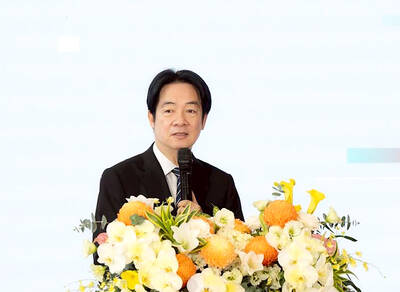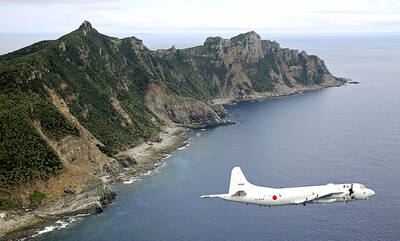Typhoon Sinlaku lashed Taiwan yesterday with powerful winds and heavy rains, disrupting flights and train services and cutting electricity supply to almost 50,000 households.
The Central Weather Bureau said that although the storm’s eyewall — the ring of towering thunderstorms surrounding the eye where the most severe weather occurs — could be damaged after hitting land, Sinlaku would maintain its structure and remain a serious threat.
The slow-moving typhoon, with a 250km radius, is not expected to completely leave Taiwan until Tuesday and will have the greatest impact sometime before this afternoon, said Fred Tsai (蔡甫甸), a senior forecaster at the bureau.

SOURCE: CENTRAL WEATHER BUREAU
During that period, rainfall in the northern, northeastern, eastern, central and southern parts of Taiwan could reach the “extremely heavy rain” or “torrential rain” categories, defined respectively as rainfall exceeding 130mm and 200mm over a 24-hour period, he said.
The mountainous areas in these regions could even see “extremely torrential rain,” which refers to rainfall exceeding 350mm in 24 hours, Tsai said, warning people across the country — particularly those in coastal and mountainous regions — to take precautions against flooding and mudslides.
The bureau said that from Friday until 4pm yesterday, accumulations had reached 591mm at Taipingshan (太平山) in Ilan County, 552mm at Lalashan (拉拉山) in Taoyuan County, 545mm in the Tonghou (桶後) area in Taipei County and 506mm at Siciousihshan (西丘斯山) in Hsinchu County.

PHOTO: CHANG CHUNG-YI, TAIPEI TIMES
Tsai said the eye of the storm was likely to skirt the nation’s northeastern coast early today, resulting in a brief period of calm weather.
At 9:15 pm last night, Sinlaku was 70km east-southeast of Ilan, moving west-northwesterly at 6kph, packing maximum sustained winds of 173kph toward the eastern coast.
A 21-year-old man was reported injured in Taoyuan County after being hit by a collapsed fence while riding his motorcycle on Friday night.
Of the 86,108 households that lost electricity from the typhoon, power was restored in all but some 6,000 as of 5:30 pm yesterday, the Central Emergency Operation Center said.
The center said 249 groups of hikers had returned from mountains they were climbing before the typhoon arrived, while seven groups, with a total of 28 people, sought shelter in the mountains after hearing of the storm.
Most rail services and domestic flights were cancelled and all international flights departing from Taiwan Taoyuan International Airport were suspended for seven hours from 14:30pm yesterday. Thousands of fishing boats were also sheltering in ports.
In response to the severe weather conditions, the Taiwan Railway Administration suspended all regular train services before midnight last night, while commuter trains ran as weather permitted. The Taiwan High Speed Rail Corp provided only limited service. All ferry services connecting Taiwan proper to Matsu, Ludao (綠島), Lanyu (蘭嶼), Little Liouciou (小琉球) and Penghu County were canceled.
ADDITIONAL REPORTING BY LOA IOK-SIN

MISINFORMATION: The generated content tends to adopt China’s official stance, such as ‘Taiwan is currently governed by the Chinese central government,’ the NSB said Five China-developed artificial intelligence (AI) language models exhibit cybersecurity risks and content biases, an inspection conducted by the National Security Bureau (NSB) showed. The five AI tools are: DeepSeek, Doubao (豆包), Yiyan (文心一言), Tongyi (通義千問) and Yuanbao (騰訊元寶), the bureau said, advising people to remain vigilant to protect personal data privacy and corporate business secrets. The NSB said it, in accordance with the National Intelligence Services Act (國家情報工作法), has reviewed international cybersecurity reports and intelligence, and coordinated with the Ministry of Justice Investigation Bureau and the National Police Agency’s Criminal Investigation Bureau to conduct an inspection of China-made AI language

LIMITS: While China increases military pressure on Taiwan and expands its use of cognitive warfare, it is unwilling to target tech supply chains, the report said US and Taiwan military officials have warned that the Chinese People’s Liberation Army (PLA) could implement a blockade within “a matter of hours” and need only “minimal conversion time” prior to an attack on Taiwan, a report released on Tuesday by the US Senate’s China Economic and Security Review Commission said. “While there is no indication that China is planning an imminent attack, the United States and its allies and partners can no longer assume that a Taiwan contingency is a distant possibility for which they would have ample time to prepare,” it said. The commission made the comments in its annual

‘TROUBLEMAKER’: Most countries believe that it is China — rather than Taiwan — that is undermining regional peace and stability with its coercive tactics, the president said China should restrain itself and refrain from being a troublemaker that sabotages peace and stability in the Indo-Pacific region, President William Lai (賴清德) said yesterday. Lai made the remarks after China Coast Guard vessels sailed into disputed waters off the Senkaku Islands — known as the Diaoyutai Islands (釣魚台) in Taiwan — following a remark Japanese Prime Minister Sanae Takaichi made regarding Taiwan. Takaichi during a parliamentary session on Nov. 7 said that a “Taiwan contingency” involving a Chinese naval blockade could qualify as a “survival-threatening situation” for Japan, and trigger Tokyo’s deployment of its military for defense. Asked about the escalating tensions

DISPUTE: A Chinese official prompted a formal protest from Tokyo by saying that ‘the dirty head that sticks itself out must be cut off,’ after Takaichi’s Taiwan remarks Four armed China Coast Guard vessels yesterday morning sailed through disputed waters controlled by Japan, amid a diplomatic spat following Japanese Prime Minister Sanae Takaichi’s comments on Taiwan. The four ships sailed around the Senkaku Islands — known as the Diaoyutai Islands (釣魚台) to Taiwan, and which Taiwan and China also claim — on Saturday before entering Japanese waters yesterday and left, the Japan Coast Guard said. The China Coast Guard said in a statement that it carried out a “rights enforcement patrol” through the waters and that it was a lawful operation. As of the end of last month,